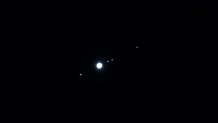What to Know
- A Great Conjunction is when the gas giants Jupiter and Saturn appear close together when viewed from Earth.
- On Dec. 21, the planets will appear so close together that they will almost look like one point of light to the unaided eye.
- For this Great Conjunction, Jupiter and Saturn will be closer together in the sky than in other years. In fact, this is the closest the planets have been in the sky since 1623.
A rare astronomical event is happening in the evening sky.
Did you get a photo? Share it with us by clicking here.
It is dubbed the “Christmas Star,” except this isn’t some distant star. It's two planets in our Solar System.
A Great Conjunction is when the gas giants Jupiter and Saturn appear close together when viewed from Earth. On Dec. 21, the planets will appear so close together that they will almost look like one point of light to the unaided eye. The two planets will be just above the horizon, and will set a few hours after the Sun.
While Jupiter and Saturn may appear close in the night sky, they are anything but close together. The planets are still roughly 400-million miles apart. Our viewpoint from Earth is what makes the planets look like they are touching, it is also what makes this event so rare.
Earth’s orbit around the Sun takes a year, but for Jupiter and Saturn it takes much longer. Jupiter takes nearly 12 years to complete one trip around the Sun, and for Saturn it takes just over 29 years! The difference in time to complete an orbit is why Great Conjunctions happen only every 20 years.
So what makes this so different from other Great Conjunctions?
For this Great Conjunction, Jupiter and Saturn will be closer together in the sky than in other years. In fact, this is the closest the planets have been in the sky since 1623. However, in that event the planets were not easily visible because they dropped below the horizon before it was dark enough to observe with the naked eye.
You would have to go back 794 years to 1226 to find a visible Great Conjunction like the one we will see on Dec. 21. If you miss out on this event, you will have to wait until 2080 to catch another Great Conjunction with both planets this close together.
Since both planets will be so close, you should be able to view both of them in the same view when using a telescope or a pair of binoculars. If you have a powerful enough telescope or binoculars, you may also spot the major moons of both planets. The moons will look like tiny dots of light in along a line that cuts through the planet.

Happy viewing, and make sure to send along any pics you take of the Great Conjunction!



